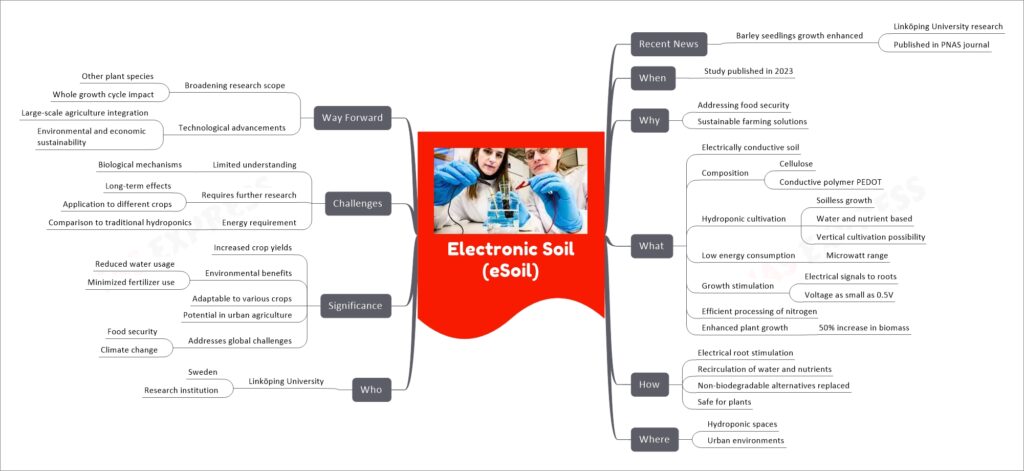Electronic Soil (eSoil)
This topic of “Electronic Soil (eSoil)” is important from the perspective of the UPSC IAS Examination, which falls under General Studies Portion.
Introduction
In 2023, the world of agriculture witnessed a groundbreaking discovery that holds the promise of addressing crucial global challenges—food security and climate change. Researchers at Linköping University unveiled the remarkable potential of Electronic Soil (eSoil), an innovative concept with the potential to revolutionize farming as we know it. This article delves into the ‘what,’ ‘why,’ ‘how,’ ‘where,’ and ‘who’ of eSoil, examining its significance, challenges, and the way forward.
What is eSoil?
eSoil is an electrifying breakthrough in agriculture. It involves the creation of electrically conductive soil, combining cellulose and conductive polymer PEDOT. This unique composition allows for hydroponic cultivation, a method that eliminates the need for traditional soil, relying instead on a water and nutrient-based system. Key components of eSoil include:
- Electrically conductive soil: Combining cellulose and conductive polymer PEDOT.
- Hydroponic cultivation: Soilless growth with water and nutrient-based systems, offering vertical cultivation possibilities.
- Low energy consumption: Operates in the microwatt range.
- Growth stimulation: Delivers electrical signals to plant roots, with voltages as small as 0.5V.
- Efficient nitrogen processing: Optimizes nutrient utilization.
- Enhanced plant growth: Demonstrated a remarkable 50% increase in biomass.
Why eSoil?
eSoil emerges as a vital solution to address the pressing issues of food security and sustainability in agriculture. The motivations behind its development include:
- Addressing food security: Ensuring a stable and sufficient food supply for the growing global population.
- Sustainable farming solutions: Promoting eco-friendly practices in agriculture to combat climate change.
How does eSoil work?
eSoil’s success is attributed to its unique methods:
- Electrical root stimulation: By delivering electrical signals to plant roots, it enhances growth.
- Recirculation of water and nutrients: Minimizes resource wastage.
- Non-biodegradable alternatives replaced: A sustainable approach.
- Safe for plants: eSoil poses no harm to plant health.
Where can eSoil be used?
The adaptability of eSoil makes it suitable for various settings:
- Hydroponic spaces: Ideal for controlled indoor environments.
- Urban environments: Offers the potential for sustainable urban agriculture.
Who is Behind eSoil?
Linköping University in Sweden, a renowned research institution, stands at the forefront of eSoil’s development.
Significance of eSoil
eSoil’s potential impact on agriculture and the environment is significant:
- Increased crop yields: Offers a promising solution to global food production challenges.
- Environmental benefits: Reduces water usage and minimizes fertilizer use, contributing to sustainability.
- Adaptable to various crops: Versatility in application.
- Potential in urban agriculture: Addresses the need for sustainable urban food production.
- Addresses global challenges: Tackles food security and climate change head-on.
Challenges and the Way Forward
While eSoil holds immense promise, it is not without challenges:
- Limited understanding: More research is needed to fully grasp the biological mechanisms at play.
- Requires further research: The long-term effects and applicability to different crops require extensive investigation.
- Energy requirement: Comparing energy consumption to traditional hydroponics is essential.
The way forward involves:
- Broadening research scope: Studying its impact on various plant species and considering the entire growth cycle.
- Technological advancements: Integrating eSoil into large-scale agriculture and ensuring both environmental and economic sustainability.
Conclusion
Electronic Soil (eSoil) is not merely a scientific marvel but a beacon of hope for sustainable agriculture. Its ability to boost crop yields, conserve resources, and mitigate environmental impacts makes it a game-changer in the quest for a brighter, greener future in farming. With ongoing research and technological advancements, eSoil promises to revolutionize agriculture and contribute significantly to addressing global challenges.


